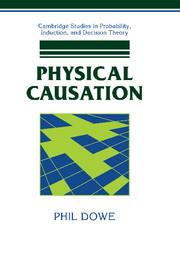Book contents
- Frontmatter
- Contents
- Acknowledgements
- 1 Horses for Courses: Causation and the Task of Philosophy
- 2 Hume's Legacy: Regularity, Counterfactual and Probabilistic Theories of Causation
- 3 Transference Theories of Causation
- 4 Process Theories of Causation
- 5 The Conserved Quantity Theory
- 6 Prevention and Omission
- 7 Connecting Causes and Effects
- 8 The Direction of Causation and Backwards-in-Time Causation
- References
- Index
7 - Connecting Causes and Effects
Published online by Cambridge University Press: 13 October 2009
- Frontmatter
- Contents
- Acknowledgements
- 1 Horses for Courses: Causation and the Task of Philosophy
- 2 Hume's Legacy: Regularity, Counterfactual and Probabilistic Theories of Causation
- 3 Transference Theories of Causation
- 4 Process Theories of Causation
- 5 The Conserved Quantity Theory
- 6 Prevention and Omission
- 7 Connecting Causes and Effects
- 8 The Direction of Causation and Backwards-in-Time Causation
- References
- Index
Summary
The account of causal processes and interactions – the Conserved Quantity theory – offered in Chapter 5 was cast as a minimal account in the sense that it does no more than explicate the key notions of causal processes and interactions. We may still ask how this is relevant to the events we call causes and effects. If two events (or facts, states of affairs, whatever) are related as cause and effect, what causal processes and interactions must there be? This second question, what is the connection between causes and effects?, is the subject of the present chapter.
We might expect that the process theory would provide necessary and sufficient conditions for singular causation in the following way: two token events are connected in a causal relation if and only if a continuous line of causal processes and interactions can be traced between them. Call this the naïve process theory. In section 7.1 we shall see that because of the problem of 'misconnections' this is inadequate as an analysis, the implication being that the account given in Chapter 5 needs to be developed or supplemented in some way.
In Chapter 2 we saw probabilistic (chance-raising) theories have problems with certain chance-lowering cases. A common way to deal with that problem is to supplement the chance-raising theory with some notion of a causal process. This suggests the idea that such a combination may also solve the problem of misconnections. Section 7.2 is a critical review of so-called 'integrating' theories – theories that attempt to provide a satisfactory analysis by combining the probabilistic theory with the process theory.
- Type
- Chapter
- Information
- Physical Causation , pp. 146 - 175Publisher: Cambridge University PressPrint publication year: 2000

